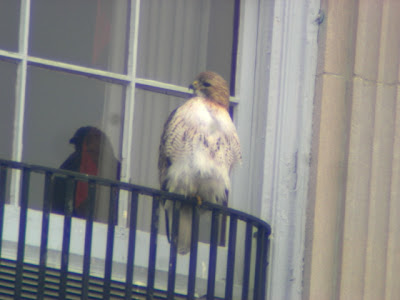 A hawk's eye view of Pale Male and Lola's nest(See one of the 2007 eggs peeping out just beyond the masonry. No wonder the eggs were still in the nest, there are very few angles in which a predator might see them. Smart parents, these hawks.)FROM NEW YORK CITY AUDUBON---Lending nature a helping hand
A hawk's eye view of Pale Male and Lola's nest(See one of the 2007 eggs peeping out just beyond the masonry. No wonder the eggs were still in the nest, there are very few angles in which a predator might see them. Smart parents, these hawks.)FROM NEW YORK CITY AUDUBON---Lending nature a helping hand
NEW YORK, NY – Spring spruce-up came early to the red-tailed hawk nest on the façade of 927 Fifth Avenue. Scaffold workers, directed by New York City Audubon, repaired the nest cradle mounted atop a 12th floor cornice of the building. Although the work done required only a few hours, it could be critical to the birds’ ability to produce chicks this spring and in the years to come.
Pale Male and Lola, the beloved red-tailed hawk pair, have had no success hatching chicks since re-establishing their nest on the cradle in spring 2005. Prior to that date Pale Male and his mate produced chicks each year from 1995 through 2004 – a total of 26 hatchlings, of which 19 survived to fledge – making Pale Male one of the most successful red-tailed hawks ever documented. Concerned by the correlation of lack of propagation and construction, NYC Audubon enlisted four red-tailed hawk experts around the country to study the situation and present conclusions.
At the panel’s request, NYC Audubon arranged for two wildlife photographers, Jeff Kollbrunner and Donegal Browne, to take photos of the interior of the nest from the building’s roof on January 4.. Those pictures showed that stainless steel pigeon spikes extend above the nest material, posing a serious threat to successful embryo development during the 5-6 week egg incubation period. Birds must roll their eggs so that fluids within the egg are gently distributed and the tissues don’t stick together and form a dense mass. The erect spikes appear to impede this critical step and also to interfere with the hen’s ability to make proper contact of the eggs to her brood patch, keeping the eggs consistently warm. An observer reported that the hen’s brood patch appeared to be rubbed raw this past nesting season.
Braced with that evidence and the panel’s recommendation to remove the spikes beneath the nest bowl, NYC Audubon worked with various NYC authorities and the building’s coop board to obtain permission to remove the spikes from the nest cradle. The task was time-critical; early February marks the start of copulation.
"I'm so pleased to learn that this crucial project went forward and came to some useful completion -- just in time, too,” said John Blakeman, an expert on red-tailed hawks, and the author of NYC Audubon’s report . “I commend everyone who brought all of this together, especially the people at NYC Audubon. It's one thing to educate the public on natural resources and conservation problems, which Audubon intelligently does. But it's another matter to step forward, commit institution resources, and actually get things done. Words can be cheap. Rectifying difficult conservation issues can be expensive, as this surely was.”
“NYC Audubon has taken a brave and difficult step. No matter what the outcome -- and you never know in the unpredictable world of nature --we Pale Male and Lola fans will be forever grateful to them,” said Marie Winn, author of Red-tails in Love: Pale Male's Story. There is no guarantee that this improvement of the birds’ habitat will mean chicks in mid-April, as the recent lack of reproductive success may have other causes. However, as one NYC Parks & Recreation official said, “I’m hawkish about what we’re doing.”
NYC Audubon would especially like to thank the Richard Cohen and the Board of 927 5th Avenue, NYC Parks and Recreation Commissioner Adrian Benepe, and Sandy Fiebelkorn, a board member of NYC Audubon and the volunteer who coordinated this extraordinary effort.
NYC Audubon
And from the Hawkwatchers and all on this end, we would like to extend a big thank you to those mentioned above plus Red-tailed Hawk expert John Blakeman, Aimee van Dyne, NYC Audubon, and their Executive Director Glenn Phillips as well.(They're are still more photos and details of the story to come. Stay tuned!)Donegal Browne
























































